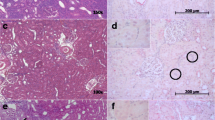Abstract
Clinical as well as experimental studies have found an interindividual variability in the immunosuppressive effect of cyclosporine (CsA). In renal transplant patients treated with CsA and prednisolone alone, biopsy-verified rejections were significantly more frequent in DRw6-positive than in DRw6-negative graft recipients. The relative risk for developing a graft rejection independently of the CsA blood levels increased in HLA-DRw6-positive transplant patients. Although no statistical significance of the CsA levels within different DR phenotypes could be assessed, HLA-DR2-positive graft recipients with biopsy-verified rejection episodes had significantly lower CsA levels than DR2-negative patients (P = 0.01). Our results would indicate a very low CsA sensitivity of HLA-DRw6-positive graft recipients and might explain previous results describing an increased incidence of rejection and decreased graft survival rates in these patients.
Access this chapter
Tax calculation will be finalised at checkout
Purchases are for personal use only
Similar content being viewed by others
References
Cook D (1986) HLA-DR associated immune responsiveness. In: Terasaki P (ed) Clinical transplants. UCLA Tissue Typing Laboratory, Los Angeles, pp 247–256
Ferguson R, Canafax D, Sawchuck R, Simmons R (1986) Cyclosporin blood level monitoring: the early posttransplant period. Transplant Proc 28 (2) [Suppl 1]: 113–116
Hamilton G, Roth E, Wallisch E, Tichy F (1985) Semi-automated high performance liquid chromatographic determination of cyclosporin A in whole blood using one-step sample purification and column-switching. J Chromatogr 341:411–419
Hendriks G, Schreuder G, Claas F, D’Amaro J, Persijn G, Cohen B, van Rood J (1983) HLA-DRw6 and renal allograft rejection. BMJ 286:85–87
Hoitsma A, van Lier H, Reekers P, Koene R (1985) Treatment of acute rejection of cadaveric renal allografts with rabbit antithymocyte globulin: influence of blood transfusion and DRw6. Transplant Proc 1:72–74
Kahan BD (1985) Individualization of cyclosporine therapy using pharmacokinetic and pharmacodynamic parameters. Transplantation 40:457–476
Kahan BD, Grevel J (1988) Optimization of cyclosporine therapy in renal transplantation by a pharmacokinetic strategy. Transplantation 46:631–644
Kasiske L, Hein-Duthoy K, Rao V, Awin M (1988) The relationship between cyclosporine pharmacokinetic parameters and subsequent acute rejection in renal transplant recipients. Transplantation 46:716–722
Persijn G, D’Amaro G, De Lange P, Schreuder T, Thorogood J, Zantvoort F, Rood J van (1989) The effect of mismatching and sharing of HLA, B and DR antigens on kidney graft survival in eurotransplant 1982 to 1988. In: Terasaki (ed) Clinical transplant, UCLA Tissue Typing Laboratory, Los Angeles, p 237
Povlsen J, Rasmussen A, Madsen M, Lamm L (1990) Ciclosporine-induced immunosuppression in-vitro. Scand J Immunol 32:45–51
Scorza R, Vanoli M Cigognini A, Fabio G, De Bernardi B, Zanussi C (1988) In vitro effects of cyclosporine A on allogenic and autologous lymphocyte stimulation: influence of HLA phenotypes. Transplant Proc 20 [Suppl 2]: 122–124
Zlabinger G, Pohanka E, Hajek-Rosenmayer A, Pavlicek E, Watschinger B, Traindl O, Kovarik J (1990) Influence of HLA pehnotypes on the inhibition of in vitro alloreactivity by cyclosporin A. Transplantation 50:1038–1042
Zlabinger G, Ulrich W, Pecherstorfer M, Watschinger B, Traindl O, Meron G, Pohanka E, Wolfram J, Kovarik J (1989) Clinical experience with OKT3 monoclonal antibody for treatment of acute renal allograft rejection based on sequential histological evaluation. Clin Transplant 3:215–222
Author information
Authors and Affiliations
Editor information
Editors and Affiliations
Rights and permissions
Copyright information
© 1992 Springer-Verlag Berlin Heidelberg
About this paper
Cite this paper
Kudlacek, S., Zlabinger, G.J., Pohanka, E., Hamilton, G., Rosenmayr, A., Kovarik, J. (1992). Insensitivity to cyclosporine may explain the HLA-DRw6 recipient effect. In: Kootstra, G., Opelz, G., Buurman, W.A., van Hooff, J.P., MacMaster, P., Wallwork, J. (eds) Transplant International Official Journal of the European Society for Organ Transplantation. Springer, Berlin, Heidelberg. https://doi.org/10.1007/978-3-642-77423-2_163
Download citation
DOI: https://doi.org/10.1007/978-3-642-77423-2_163
Publisher Name: Springer, Berlin, Heidelberg
Print ISBN: 978-3-540-55342-7
Online ISBN: 978-3-642-77423-2
eBook Packages: Springer Book Archive




